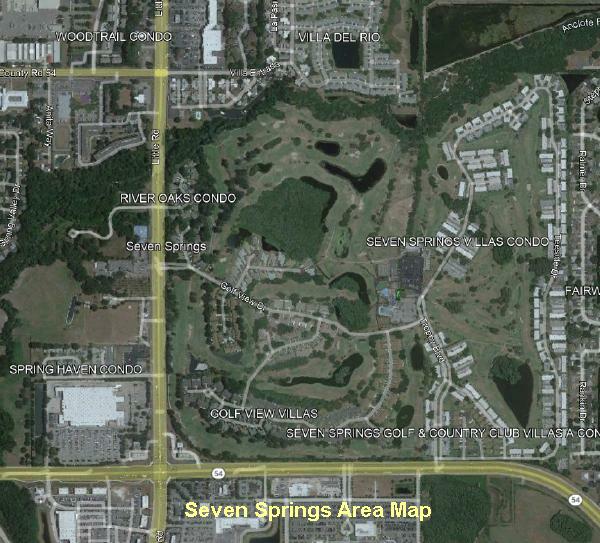
There is an area in West Pasco County referred to as "Seven Springs" located
in the vicinity of Little Road just north of State Road 54. Most of the area associated
with Seven Springs is now part of the Seven Springs subdivision that includes the
Seven Springs Golf and Country Club. (See image for a map of the area where Seven
Springs is located.)
At the entrance to the Seven Springs subdivision at Little Road and Golf View Drive,
there is an historical marker (see image) that reads,
"Early residents of this area were Samuel H. Stevenson and his wife, Elizabeth,
who believed in the therapeutic benefits of the mineral springs now known as Seven
Springs. It became somewhat of a health resort after Stevenson created a pool by
installing a well pipe and diverting water from a spring. The pool overflowed into
the Anclote River, where a small bath house was built for guests and mineral water
was given to anyone who wanted it. An old iron bridge with wood decking was nearby.
A truck carrying molasses once fell through it. The Seven Springs School, which
was built on land owned by T.J. Witt, served local families from about 1913 to
1925. His widow later made the school into her residence and her son and daughter-in-law,
Ed and Willie Maude Frierson, later lived in the building as well. Mrs. Frierson
operated a small dairy after World War II. When the property was sold for development,
the school building was moved in 1981 to Sims Park in New Port Richey and became
the West Pasco Historical Society Museum. This former pioneer settlement and early
resort area is part of what is now Seven Springs Golf and Country Club and the Trinity
Community."

This historical marker gives us a lot of information. It tells us that the founder
of Seven Springs was Samuel H. Stevenson. He lived from 1810 until 1897, and was
one of the original pioneer settlers of Pasco County. Samuel and his extended family
and descendants made numerous contributions to the history and settlement of the
area. Many of the Stevensons are buried in the nearby East Elfters Cemetery (see
photo of Samuel Stevenson's headstone).
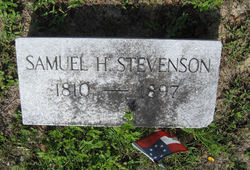
We also learn that there was a Seven Springs school that was used between 1913 and
1925, and later that it was used as a private residence.
Where exactly was the schoolhouse? Looking at the area map of Seven Springs, it
was at the northeast corner of Little Road and Golf View Drive.
As stated on the historical marker, the schoolhouse building was moved in 1981 to
Sims Park in downtown New Port Richey to become the West Pasco Historical Society
Museum (see picture).
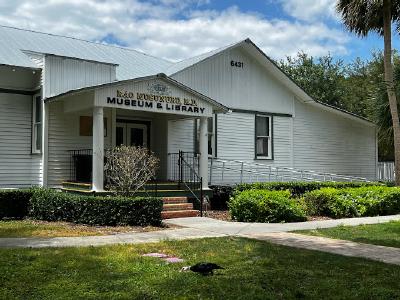
The exact year when a pool, bath house, and resort area
were developed are not known. But it was most likely in the late 1910s. The existence of a spring at the location along the Anclote River
was known as early as 1848, and sometimes referred to as "Sulphur Springs".
Some early maps show the river called "Sulphur Creek". In any case, it
is reported that the bath house and pool was destroyed by flooding from a hurricane
in 1921.
The description on the historical marker of a truck carrying molasses falling through
the bridge is almost completely irrelevant since that event happened in 1949 ...
long after the resort at Seven Springs had been destroyed. It does,
however, point out that the area in question was in the proximity of the bridge
over the Anclote River at that location.
Many Pasco County residents, particularly residents who live in the area, may wonder
... if it's called "Seven Springs", where are the seven springs? A
good question that not many people have knowledge about. There are many clues ...
obviously, the springs would be somewhere in the general vicinity of the Seven Springs
area. And since we know that they fed into a pool that overflowed into the Anclote
River, they must be very close to the river. But if you go into the Seven Springs
development, there is no sign of any site where a spring is, or might have been
in the past. So where are the seven springs?
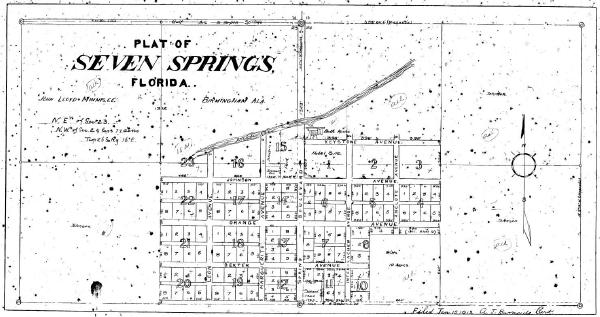
For an answer to this question,
we need to go back to the original plat maps of Seven Springs in the early 1900s.
Included here is an image of the original 1912 plat map submitted to Pasco County
for development of the Seven Springs resort.
Note that the road now known as County Road 54 is named Gulf Avenue to Tarpon
Springs. And the road currently known as Little Road is named Spring Boulevard.
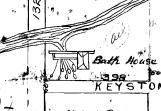
On the plat map,
the location of the pool and bath house is shown on the east side of the road just
south of the Anclote River. It's difficult to make out in this image of the
plat map, so a closeup image is provided here.
Note that there are seven springs shown in the illustration, all connected to the
pool. They are all within a hundred feet of each other. So obviously there aren't
really seven different springs. There are just seven vents coming from a single
spring. The plat drawing also shows how the pool overflowed into the river. It appears
that the pool was simply built abreast of a short spring run that fed into the Anclote
River.
Also noteworthy
is that there is a block labeled "Hotel Site". There are no records or
accounts of a hotel ever being built at this location.
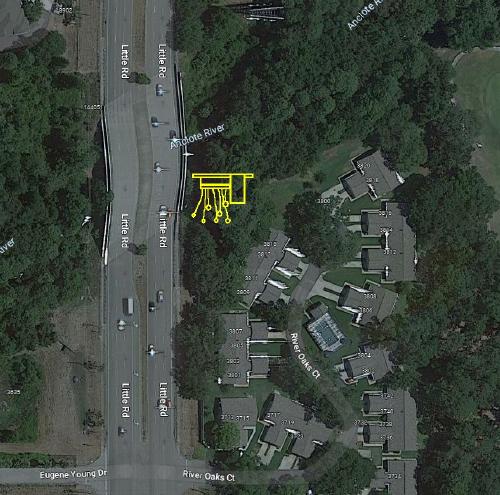
An interesting point to note
is that the exact location of the springs, the pool, and the bath house, is not
within the boundaries of the Seven Springs Golf and Country Club as one is led to
believe. (See the photo here showing where the pool and bathhouse would be on a
current map.)
The small subdivision shown here just south of the Anclote River and east of Little
Road, is actually called "River Oaks". The location of the seven springs
and associated resort of old would likely reside on property between the river
and the River Oaks subdivision.